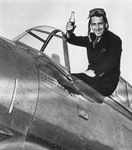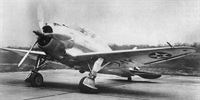Фотографии
-
An improved version of the P-35 was ordered by the Swedish Air Force, and first appeared in 1939. Of the original order of 120 EP-106s (designated J-9 by the Swedes), 60 had been delivered by the advent of war. The US Army Air Corps requisitioned the remainder of the aircraft and put them in service as P-35As. The J-9 carried two 0-30in machine-guns in the top cowling, two 0-50ins in each wing, plus five small fragmentation bombs underwing. A 1,100 h.p. Pratt & Whitney R-1830-SC3 Twin Wasp radial engine provided a 320 m.p.h. top speed at 14,000ft and a cruising speed of 290 m.p.h. One J-9 is retained in the Swedish Air Force Museum at Linkoping.
Самолёты на фотографии: Seversky P-35 - США - 1936
-
One of the EP-106s (EP stood for “export pursuit”) converted to a P-35A for use with the US Army Air Corps. The type served for two years in the Philippines, replacing elderly Boeing P-26s and bolstering the island’s defences. By May 1941 the 3rd, 17th and 20th Pursuit Squadrons were operating a total of 48 P-35As, which still had Swedish instrumentation. Engine and maintenance problems handicapped the P-35s, which also lacked oxygen for high-altitude flying and ammunition for their guns.
Самолёты на фотографии: Seversky P-35 - США - 1936
-
Maj de Seversky and the first production P-35 following its first flight.
Самолёты на фотографии: Seversky P-35 - США - 1936
-
Регистрационный номер: X1254 [2] The NF-1 in flight. The engine mass would have restricted the forward view during carrier operations.
Самолёты на фотографии: Seversky P-35 - США - 1936
-
Регистрационный номер: X1254 [2] The NF-1, or Navy Fighter 1, was a proposed US Navy carrier fighter which was tested and demonstrated in late 1937. It employed Seversky’s early undercarriage, which retracted rearwards, and had wheel fairings to enclose the protruding wheels. It was also fitted with an arrester hook. But with no Navy orders forthcoming the hook was removed and the aircraft continued flying as a company demonstrator.
Самолёты на фотографии: Seversky P-35 - США - 1936
-
The XP-41 was designed as a high-speed, low-altitude fighter and was the reworked last production P-35. Based on Seversky’s AP-4 design, it also served as an engine testbed and it was said that it was the only aircraft at the time capable of accommodating the 1,200 h.p. R-1380 Twin Wasp. Its performance was excellent and it was the first single-seat fighter to exceed 300 m.p.h. in level flight. The project never went further than the single prototype, as the military opted for the follow-on P-43 design already in the works.
Самолёты на фотографии: Seversky P-35 - США - 1936
-
Самолёты на фотографии: Seversky P-35 - США - 1936
-
Another view of the prototype YP-43 Lancer, pictured at Floyd Bennett Field. The single-seater had smooth, flush-riveted skinning and a turbocharger for high-altitude combat. The 1,200 h.p. Pratt & Whitney R-1830 engine gave the aircraft a maximum speed of around 350 m.p.h. More than 270 P-43 series aircraft were produced and many were sent to India and China in the early Forties.
Самолёты на фотографии: Republic P-43 Lancer - США - 1940
-
Регистрационный номер: R1250 [2] The prototype Lancer, designated YP-43, during flight testing at Floyd Bennett Field in 1941, pictured following some kind of accident - damage to R1250’s airframe appears to be minimal. The aircraft started with the Seversky name but a company change to forestall bankruptcy resulted in its becoming a Republic Aviation aircraft in production. It was the world’s first 300 m.p.h. production aeroplane.
Самолёты на фотографии: Republic P-43 Lancer - США - 1940
-
Регистрационный номер: R1250 [2] Самолёты на фотографии: Republic P-43 Lancer - США - 1940
-
Регистрационный номер: NX1291 [3] The late James Doolittle landing at Roosevelt Field in his DS-1 Executive (DS stood for Doolittle Special). The aircraft was purchased by Shell Oil Company for use by Doolittle in experimental flying, and also as an executive transport with a passenger carried in the rear seat. He took delivery of the Seversky on September 7, 1937. He told Howard Levy that his last logged flight in the aircraft was made on June 19, 1940. The characteristic wing planform was later to become a distinctive feature of the Republic P-47 Thunderbolt, a direct descendant of the Seversky monoplanes.
Самолёты на фотографии: Seversky SEV-2PA / AT-12 - США - 1937
-
Регистрационный номер: NX1384 [3] Jackie Cochran taxying in at Floyd Bennett Field, New York, in the Seversky AP-7 NX1384 after winning the 1938 Bendix Race, which netted her $12,500 in prize money. Cochran was the first woman to fly faster than sound (in a Canadair Sabre Mk 3); she died on August 9, 1980, aged 74.
Самолёты на фотографии: Seversky SEV-2PA / AT-12 - США - 1937
-
Регистрационный номер: NX1384 [3] Maj Alexander de Seversky in Jackie Cochran’s AP-7, bearing her race No 13, at Floyd Bennett Field.
Самолёты на фотографии: Seversky SEV-2PA / AT-12 - США - 1937
-
Регистрационный номер: NX1384 [3] NX1384 again, possibly Cochran’s AP-7 reworked with the aft-retracting faired undercarriage replaced by a new inboard-swinging fully-retracting main gear. Access for a passenger was via an entrance door/window aft of the pilot’s cockpit.
Самолёты на фотографии: Seversky SEV-2PA / AT-12 - США - 1937
-
The Swedish government also ordered 50 of the two-seat 2PA series aircraft. Carrying the factory designation 2PA-204A, they were intended to serve as dive-bombers. Only two reached Sweden; the onset of war diverted the remaining aircraft to the US Army Air Corps as AT-12 Guardsmen. The 2PA was essentially a P-35A with a lengthened fuselage to accommodate the second seat; a further 5ft was added to the wingspan. In addition to two 0-30in machine-guns carried in the nose and another carried in the rear cockpit, a total of 1,350lb of bombs could be carried. Pictured here at Logan Airport, Mass, is an AT-12 modified by the AAC Flight Test Center at Wright Field.
Самолёты на фотографии: Seversky SEV-2PA / AT-12 - США - 1937
-
Another view of the modified AT-12 taken as the pilot waves “so long” to photographer Howard Levy at Logan Airport, Massachusetts. The added ventral and dorsal fins were a modification carried out by the Test Center at Wright Field.
Самолёты на фотографии: Seversky SEV-2PA / AT-12 - США - 1937
-
Регистрационный номер: N55539 Seversky AT-12 N55539, minus wheel fairings, seen shortly after restoration. It is currently based at Chino, California, with the Air Museum Planes of Fame Collection.
Самолёты на фотографии: Seversky SEV-2PA / AT-12 - США - 1937
-
Регистрационный номер: NX1291 [3] Jimmy Doolittle’s DS-1. It was later ferried to Roosevelt Field by an unknown pilot, and collided with the wind-tee on landing. It is thought that the oil on the windscreen obscured the pilot’s view; the damage was considerable.
Самолёты на фотографии: Seversky SEV-2PA / AT-12 - США - 1937
-
Регистрационный номер: NX1291 [3] Howard Levy later photographed NX1291 dismantled at Roosevelt Field when numerous aircraft were being prepared for shipment to England before America’s entry into the war. Was the DS-1 one of those aircraft?
Самолёты на фотографии: Seversky SEV-2PA / AT-12 - США - 1937
Статьи
- -
- EKW C-3603 HB-RBI/C-547 /Preservation Profile/
- Personal album. Civil
- A.Robertson - Mayday!
- B.Grimstead - Handling the Harvard
- B.Jones - Crescent-wing Crusader /British post-war experimental jet aircraft/ (11)
- B.Robertson - An AID to quality (3)
- C.Prower - From Brisfit to Beverley: Flying pantechnicon (9)
- G.Bain - Water Gipsy
- H.Levy - Seversky (2)
- J.Stroud - Fiat G.12 and G.212 /Post-war propliners/
- M.Hiscock - Ravel's Bel Aero
- M.Oakey - Grapevine
- M.Roffe, D.Baker - Great moments in aviation (3)
- P.Jarrett - By day and by night: Fairey Fox (2)
- P.Lamboit - PRU at war
- R.Beamont - Hurricane baptism
- R.Dennis - Farnborough's caterpillars (1)


















